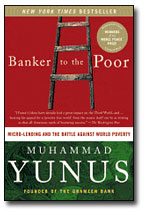Books |
Banker to the Poor
Muhammad Yunus
By
Published: Jan 01, 2007
Category:
Non Fiction
Because we are all financially sophisticated here, we know that the time to borrow money is when rates are low and you don’t need it.
What do you do with the loan?
“Nothing” will do.
The point is to beef up your credit rating so when you really need to borrow, the bank will have no reason to reject you.
Until Muhammad Yunus and the Grameen Bank came along, it was a little different for the poor — and especially poor women — in Bangladesh.
But in 1974 a great famine struck Bangladesh. Yunus was then a young economics professor. "We tried to ignore the famine," he recalls. "But then skeleton-like people began showing up in the capital, Dhaka. Soon the trickle became a flood. Hungry people were everywhere. Often they sat so still that one could not be sure whether they were alive or dead. They all looked alike: men, women, children. Old people looked like children, and children looked like old people.”
Nothing in his academic studies suggested a solution. Soon his lectures seemed empty: “How could I go on telling my students make believe stories in the name of economics? I needed to run away from these theories and from my textbooks and discover the real-life economics of a poor person’s existence."
What Yunus discovered — and what he did about it — led him and his Grameen Bank to be awarded the 2006 Nobel Peace Prize.
Essentially, Yunus did what all great capitalists do: He learned from his customers. He saw that poor women were the poorest of the poor, earning as little as two cents a day. And because they were exhausted and despised, they were doomed to remain poor — and to bestow on their children a legacy of poverty. But they were not stupid. They were not lazy. Their poverty was not of their making. They were simply excluded from the economic system — except, of course, for their great utility as a source of cheap labor.
So Yunus made a list of women who seemed like worthy borrowers. And, from his own pocket, he loaned 42 women a total of $27. His “bank” was the opposite of a traditional financial institution. The women put up no collateral. The bank had no lawyers. His “bankers” went to villages and fields to offer their services. The assumption was that every borrower was honest and would repay the loan — and he was right. Why? “The poor can’t risk not repaying. This is the only chance they have.”
Yunus takes the readers through the history of his bank. In these pages, you will meet people of astonishing goodness — people with small loans who devote themselves wholeheartedly to repaying them and building their fledgling businesses. Along the way, they become role models in their communities. They have fewer children — and their kids go to school.
Talk about inspiring! In 30 years, Grameen’s 1,417 branches have provided $4.7 billion dollars to 4.4 million families in rural Bangladesh — the bank now serves 51,000 villages, three quarters of all the villages in Bangladesh. Its housing loans have built 640,000 houses. The repayment rate is 99%. And the Grameen Bank is profitable.
All well and good in Bangladesh, you say. Could Grameen’s methods be exported? Yunus says they can — and writes how Grameen can help the poor in America. And how loans to the poor are a much better investment against terrorism than guns.
“I firmly believe that we can create a poverty-free world if we collectively believe in it,” Yunus says. Yeah, you might call him a dreamer — but the proof is in. His dream works.
So it was completely unsurprising that when Muhammad Yunus went to Oslo to accept the Nobel Peace Prize, he brought along “nine elected representatives of the 7 million borrowers-cum-owners of the Grameen Bank.” That is, the poorest of the poor. Just poor no more.
If you’re looking for a book with a story that makes your brain sizzle and your heart pound, look no further.
To buy the paperback of “Banker to the Poor” from Amazon.com, click here.
To buy the Audio CD of “Banker to the Poor” from Amazon.com, click here.
For more information about the Grameen Bank, click here.
To read Yunus’s Nobel Peace Prize acceptance speech, click here.


